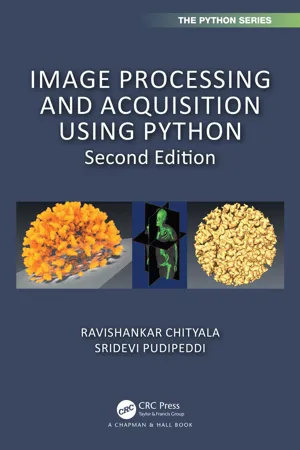
Image Processing and Acquisition using Python
Ravishankar Chityala, Sridevi Pudipeddi
- 421 pages
- English
- ePUB (adapté aux mobiles)
- Disponible sur iOS et Android
Image Processing and Acquisition using Python
Ravishankar Chityala, Sridevi Pudipeddi
À propos de ce livre
Image Processing and Acquisition using Python provides readers with a sound foundation in both image acquisition and image processing—one of the first books to integrate these topics together. By improving readers' knowledge of image acquisition techniques and corresponding image processing, the book will help them perform experiments more effectively and cost efficiently as well as analyze and measure more accurately. Long recognized as one of the easiest languages for non-programmers to learn, Python is used in a variety of practical examples.
A refresher for more experienced readers, the first part of the book presents an introduction to Python, Python modules, reading and writing images using Python, and an introduction to images. The second part discusses the basics of image processing, including pre/post processing using filters, segmentation, morphological operations, and measurements. The second part describes image acquisition using various modalities, such as x-ray, CT, MRI, light microscopy, and electron microscopy. These modalities encompass most of the common image acquisition methods currently used by researchers in academia and industry.
Features
-
- Covers both the physical methods of obtaining images and the analytical processing methods required to understand the science behind the images.
-
- Contains many examples, detailed derivations, and working Python examples of the techniques.
-
- Offers practical tips on image acquisition and processing.
-
- Includes numerous exercises to test the reader's skills in Python programming and image processing, with solutions to selected problems, example programs, and images available on the book's web page.
New to this edition
-
- Machine learning has become an indispensable part of image processing and computer vision, so in this new edition two new chapters are included: one on neural networks and the other on convolutional neural networks.
-
- A new chapter on affine transform and many new algorithms.
-
- Updated Python code aligned to the latest version of modules.
Foire aux questions
Informations
python in the terminal window. When the interpreter is started, a command prompt ( > > >) appears. Python commands can be entered at the prompt for processing. For example, in Mac, when the built-in Python interpreter is started, an output similar to the one shown below appears:(base) mac:ipaup ravi$ pythonPython 3.7.3 | packaged by conda-forge |(default, Dec 6 2019, 08:36:57)[Clang 9.0.0 (tags/RELEASE_900/final)] :: Anaconda, Inc.on darwinType "help", "copyright", "credits" or "license"for more information.>>>
python.firstprog.py is a Python file that needs to be executed, then type the following command on the OS command prompt. >> python firstprog.py Table des matières
- Cover
- Half Title
- Series Page
- Title Page
- Copyright Page
- Dedication
- Contents
- Foreword
- Preface
- Preface to the First Edition
- Introduction
- Authors
- List of Symbols and Abbreviations
- Part I: Introduction to Images and Computing using Python
- Part II: Image Processing using Python
- Part III: Image Acquisition
- Appendix A: Image Processing and Acquisition using Python
- Appendix B: Image Processing and Acquisition using Python
- Appendix C: Introduction to ImageJ
- Appendix D: Matlab® and Numpy Functions
- Bibliography
- Index